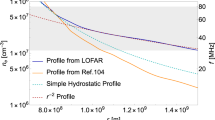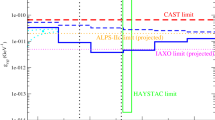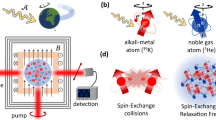Abstract
The hitherto unprecedented angular resolution of the Event Horizon Telescope has created exciting opportunities in the search for new physics. Recently, the linear polarization of radiation emitted near the supermassive black hole M87⋆ was measured on four separate days, precisely enabling tests of the existence of a dense axion cloud produced by a spinning black hole. The presence of an axion cloud leads to a frequency-independent oscillation in the electric vector position angle of this linear polarization. For the nearly face-on M87⋆, this oscillation in the electric vector position angle appears as a propagating wave along the photon ring. In this paper, we leverage the azimuthal distribution of electric vector position angle measured by the Event Horizon Telescope to study the axion–photon coupling. We propose a novel differential analysis procedure to reduce the astrophysical background, and derive stringent constraints on the existence of axions in the previously unexplored mass window of ~(10−21–10−20) eV.
This is a preview of subscription content, access via your institution
Access options
Access Nature and 54 other Nature Portfolio journals
Get Nature+, our best-value online-access subscription
$29.99 / 30 days
cancel any time
Subscribe to this journal
Receive 12 digital issues and online access to articles
$119.00 per year
only $9.92 per issue
Buy this article
- Purchase on Springer Link
- Instant access to full article PDF
Prices may be subject to local taxes which are calculated during checkout




Similar content being viewed by others
Data availability
The polarimetric measurement data used in this paper are drawn from the publicly available publication of the EHT collaboration5. The data that support the plots within this paper and other findings of this study can be found at https://github.com/XueXiao-Physics/Axion_EHT_2021.
Code availability
The simulation codes used in this study are a modified version of the publicly available code ipole33,34 (https://github.com/moscibrodzka/ipole). The data analysis codes can be found at https://github.com/XueXiao-Physics/Axion_EHT_2021.
References
Event Horizon Telescope Collaborationet al. First M87 Event Horizon Telescope results. I. The shadow of the supermassive black hole. Astrophys. J. Lett. 875, L1 (2019).
Event Horizon Telescope Collaborationet al. First M87 Event Horizon Telescope results. IV. Imaging the central supermassive black hole. Astrophys. J. Lett. 875, L4 (2019).
Event Horizon Telescope Collaborationet al. First M87 Event Horizon Telescope results. VI. The shadow and mass of the central black hole. Astrophys. J. Lett. 875, L6 (2019).
Event Horizon Telescope Collaborationet al. First M87 Event Horizon Telescope results. V. Physical origin of the asymmetric ring. Astrophys. J. Lett. 875, L5 (2019).
Event Horizon Telescope Collaborationet al. First M87 Event Horizon Telescope results. VII. Polarization of the ring. Astrophys. J. Lett. 910, L12 (2021).
Event Horizon Telescope Collaborationet al. First M87 Event Horizon Telescope results. VIII. Magnetic field structure near the event horizon. Astrophys. J. Lett. 910, L13 (2021).
Peccei, R. D. & Quinn, H. R. CP conservation in the presence of instantons. Phys. Rev. Lett. 38, 1440–1443 (1977).
Peccei, R. D. & Quinn, H. R. Constraints imposed by CP conservation in the presence of instantons. Phys. Rev. D 16, 1791–1797 (1977).
Weinberg, S. A new light boson? Phys. Rev. Lett. 40, 223–226 (1978).
Wilczek, F. Problem of strong P and T invariance in the presence of instantons. Phys. Rev. Lett. 40, 279–282 (1978).
Arvanitaki, A., Dimopoulos, S., Dubovsky, S., Kaloper, N. & March-Russell, J. String axiverse. Phys. Rev. D 81, 123530 (2010).
Preskill, J., Wise, M. B. & Wilczek, F. Cosmology of the invisible axion. Phys. Lett. B 120, 127–132 (1983).
Abbott, L. F. & Sikivie, P. A cosmological bound on the invisible axion. Phys. Lett. B 120, 133–136 (1983).
Dine, M. & Fischler, W. The not so harmless axion. Phys. Lett. B 120, 137–141 (1983).
Chen, Y., Shu, J., Xue, X., Yuan, Q. & Zhao, Y. Probing axions with Event Horizon Telescope polarimetric measurements. Phys. Rev. Lett. 124, 061102 (2020).
Penrose, R. & Floyd, R. M. Extraction of rotational energy from a black hole. Nature 229, 177–179 (1971).
Zel’Dovich, Y. B. Generation of waves by a rotating body. J. Exp. Theor. Phys. Lett. 14, 180–181 (1971).
Press, W. H. & Teukolsky, S. A. Floating orbits, superradiant scattering and the black-hole bomb. Nature 238, 211–212 (1972).
Carroll, S. M., Field, G. B. & Jackiw, R. Limits on a Lorentz and parity violating modification of electrodynamics. Phys. Rev. D 41, 1231 (1990).
Harari, D. & Sikivie, P. Effects of a Nambu–Goldstone boson on the polarization of radio galaxies and the cosmic microwave background. Phys. Lett. B 289, 67–72 (1992).
Yoshino, H. & Kodama, H. Bosenova collapse of axion cloud around a rotating black hole. Prog. Theor. Phys. 128, 153–190 (2012).
Yoshino, H. & Kodama, H. Gravitational radiation from an axion cloud around a black hole: superradiant phase. Prog. Theor. Exp. Phys. 2014, 043E02 (2014).
Yoshino, H. & Kodama, H. The bosenova and axiverse. Class. Quantum Gravity 32, 214001 (2015).
Baryakhtar, M., Galanis, M., Lasenby, R. & Simon, O. Black hole superradiance of self-interacting scalar fields. Phys. Rev. D 103, 095019 (2021).
Arvanitaki, A. & Dubovsky, S. Exploring the string axiverse with precision black hole physics. Phys. Rev. D 83, 044026 (2011).
Dolan, S. R. Instability of the massive Klein–Gordon field on the Kerr spacetime. Phys. Rev. D 76, 084001 (2007).
Schwarz, D. J., Goswami, J. & Basu, A. Geometric optics in the presence of axionlike particles in curved spacetime. Phys. Rev. D 103, L081306 (2021).
Pu, H.-Y. & Broderick, A. E. Probing the innermost accretion flow geometry of Sgr A⋆ with Event Horizon Telescope. Astrophys. J. 863, 148 (2018).
Igumenshchev, I. V., Narayan, R. & Abramowicz, M. A. Three-dimensional MHD simulations of radiatively inefficient accretion flows. Astrophys. J. 592, 1042–1059 (2003).
Narayan, R., Igumenshchev, I. V. & Abramowicz, M. A. Magnetically arrested disk: an energetically efficient accretion flow. Publ. Astron. Soc. Jpn. 55, L69 (2003).
McKinney, J. C., Tchekhovskoy, A. & Blandford, R. D. General relativistic magnetohydrodynamic simulations of magnetically choked accretion flows around black holes. Mon. Not. R. Astron. Soc. 423, 3083–3117 (2012).
Tchekhovskoy, A. in The Formation and Disruption of Black Hole Jets (eds Contopoulos, I. et al.) 45 (Astrophysics and Space Science Library Vol. 414, Springer, 2015).
Moscibrodzka, M. & Gammie, C. F. ipole—semi-analytic scheme for relativistic polarized radiative transport. Mon. Not. R. Astron. Soc. 475, 43–54 (2018).
Noble, S. C., Leung, P. K., Gammie, C. F. & Book, L. G. Simulating the emission and outflows from accretion disks. Class. Quantum Gravity 24, S259–S274 (2007).
Tamburini, F., Thidé, B. & Valle, M. D. Measurement of the spin of the M87 black hole from its observed twisted light. Mon. Not. R. Astron. Soc. 492, L22–L27 (2020).
Feng, J. & Wu, Q. Constraint on the black-hole spin of M87 from the accretion-jet model. Mon. Not. R. Astron. Soc. 470, 612–616 (2017).
Davoudiasl, H. & Denton, P. B. Ultralight boson dark matter and Event Horizon Telescope observations of M87⋆. Phys. Rev. Lett. 123, 021102 (2019).
Anastassopoulos, V. et al. New CAST limit on the axion–photon interaction. Nat. Phys. 13, 584–590 (2017).
Payez, A. et al. Revisiting the SN1987A gamma-ray limit on ultralight axion-like particles. J. Cosmol. Astropart. Phys. 02, 006 (2015).
Dessert, C., Foster, J. W. & Safdi, B. R. X-ray searches for axions from super star clusters. Phys. Rev. Lett. 125, 261102 (2020).
Marsh, M. C. D. et al. A new bound on axion-like particles. J. Cosmol. Astropart. Phys. 12, 036 (2017).
Reynolds, C. S. et al. Astrophysical limits on very light axion-like particles from Chandra grating spectroscopy of NGC 1275. Astrophys. J. 890, 59 (2020).
Kaplan, D. E. & Rattazzi, R. Large field excursions and approximate discrete symmetries from a clockwork axion. Phys. Rev. D 93, 085007 (2016).
Farina, M., Pappadopulo, D., Rompineve, F. & Tesi, A. The photo-philic QCD axion. J. High Energy Phys. 01, 095 (2017).
Raymond, A. W. et al. Evaluation of new submillimeter VLBI sites for the Event Horizon Telescope. Astrophys. J. Suppl. 253, 5 (2021).
Damour, T., Deruelle, N. & Ruffini, R. On quantum resonances in stationary geometries. Lett. Nuovo Cim. 15, 257–262 (1976).
Zouros, T. J. M. & Eardley, D. M. Instabilities of massive scalar perturbations of a rotating black hole. Ann. Phys. (N. Y.) 118, 139–155 (1979).
Detweiler, S. L. Klein–Gordon equation and rotating black holes. Phys. Rev. D 22, 2323–2326 (1980).
Strafuss, M. J. & Khanna, G. Massive scalar field instability in Kerr spacetime. Phys. Rev. D 71, 024034 (2005).
Brito, R., Cardoso, V. & Pani, P. Superradiance: New Frontiers in Black Hole Physics (Lecture Notes in Physics Vol. 906, Springer, 2015).
Cruz-Osorio, A. et al. State-of-the-art energetic and morphological modelling of the launching site of the M87 jet. Nat. Astron. 6, 103–108 (2022).
Amorim, A. et al. Scalar field effects on the orbit of S2 star. Mon. Not. R. Astron. Soc. 489, 4606–4621 (2019).
Arvanitaki, A., Baryakhtar, M. & Huang, X. Discovering the QCD axion with black holes and gravitational waves. Phys. Rev. D 91, 084011 (2015).
Brito, R., Cardoso, V. & Pani, P. Black holes as particle detectors: evolution of superradiant instabilities. Class. Quantum Gravity 32, 134001 (2015).
Ünal, C., Pacucci, F. & Loeb, A. Properties of ultralight bosons from heavy quasar spins via superradiance. J. Cosmol. Astropart. Phys. 05, 007 (2021).
Omiya, H., Takahashi, T. & Tanaka, T. Renormalization group analysis of superradiant growth of self-interacting axion cloud. Prog. Theor. Exp. Phys. 2021, 043E02 (2021).
Narayan, R., Kato, S. & Honma, F. Global structure and dynamics of advection-dominated accretion flows around black holes. Astrophys. J. 476, 49–60 (1997).
Yuan, F. & Narayan, R. Hot accretion flows around black holes. Annu. Rev. Astron. Astrophys. 52, 529–588 (2014).
Prieto, M. A., Fernandez-Ontiveros, J. A., Markoff, S., Espada, D. & Gonzalez-Martin, O. The central parsecs of M87: jet emission and an elusive accretion disc. Mon. Not. R. Astron. Soc. 457, 3801–3816 (2016).
Trippe, S. Polarization and polarimetry. J. Korean Astron. Soc. 47, 15–39 (2014).
Plascencia, A. D. & Urbano, A. Black hole superradiance and polarization-dependent bending of light. J. Cosmol. Astropart. Phys. 04, 059 (2018).
Ivanov, M. M. et al. Constraining the photon coupling of ultra-light dark-matter axion-like particles by polarization variations of parsec-scale jets in active galaxies. J. Cosmol. Astropart. Phys. 02, 059 (2019).
Fujita, T., Tazaki, R. & Toma, K. Hunting axion dark matter with protoplanetary disk polarimetry. Phys. Rev. Lett. 122, 191101 (2019).
Liu, T., Smoot, G. & Zhao, Y. Detecting axionlike dark matter with linearly polarized pulsar light. Phys. Rev. D 101, 063012 (2020).
Fedderke, M. A., Graham, P. W. & Rajendran, S. Axion dark matter detection with CMB polarization. Phys. Rev. D 100, 015040 (2019).
Caputo, A. et al. Constraints on millicharged dark matter and axionlike particles from timing of radio waves. Phys. Rev. D 100, 063515 (2019).
Yuan, G.-W. et al. Testing the ALP–photon coupling with polarization measurements of Sagittarius A⋆. J. Cosmol. Astropart. Phys. 03, 018 (2021).
Johannsen, T. & Psaltis, D. Testing the no-hair theorem with observations in the electromagnetic spectrum: II. Black-hole images. Astrophys. J. 718, 446–454 (2010).
Gralla, S. E., Holz, D. E. & Wald, R. M. Black hole shadows, photon rings, and lensing rings. Phys. Rev. D 100, 024018 (2019).
Johnson, M. D. et al. Universal interferometric signatures of a black hole’s photon ring. Sci. Adv. 6, eaaz1310 (2020).
Gralla, S. E. & Lupsasca, A. Lensing by Kerr black holes. Phys. Rev. D 101, 044031 (2020).
Jiménez-Rosales, A. et al. Relative depolarization of the black hole photon ring in GRMHD models of Sgr A⋆ and M87⋆. Mon. Not. R. Astron. Soc. 503, 4563–4575 (2021).
Marti-Vidal, I., Mus, A., Janssen, M., de Vicente, P. & Gonzalez, J. Polarization calibration techniques for the new-generation VLBI. Astron. Astrophys. 646, A52 (2021).
Acknowledgements
We are grateful to N. Houston, S. Liebersbach and D. Psaltis for careful reading and useful comments on the manuscript, and C. Li, Y.-F. Yuan, S.-S. Zhao and Z. Zhou for useful discussions. Y.C. is supported by the China Postdoctoral Science Foundation under grants 2020T130661 and 2020M680688, by the International Postdoctoral Exchange Fellowship Program and by the National Natural Science Foundation of China (NSFC) under grant 12047557. R.-S.L. is supported by the Max Planck Partner Group of the MPG and the Chinese Academy of Sciences (CAS), the NSFC under grant 11933007, the Research Program of Fundamental and Frontier Sciences of CAS under grant ZDBS-LY-SLH011 and the Shanghai Pilot Program for Basic Research—Chinese Academy of Science, Shanghai Branch (JCYJ-SHFY-2021-013). Y.M. is supported by the ERC Synergy Grant ‘BlackHoleCam: Imaging the Event Horizon of Black Holes’ under grant 610058. J.S. is supported by the NSFC under grants 12025507, 11690022 and 11947302, by the Strategic Priority Research Program and Key Research Program of Frontier Science of CAS under grants XDB21010200, XDB23010000 and ZDBS-LY-7003 and by the CAS project for Young Scientists in Basic Research YSBR-006. Q.Y. is supported by the NSFC under grants 11722328 and 11851305, by the Key Research Program of CAS under grant XDPB15 and by the Program for Innovative Talents and Entrepreneur in Jiangsu. Y.Z. is supported by the US Department of Energy under award DESC0009959. Y.C. would like to thank the SHAO and TDLI for their kind hospitality. Y.Z. would like to thank the ITP-CAS for their kind hospitality.
Author information
Authors and Affiliations
Contributions
J.S., Q.Y. and Y.Z. initiated this study, Y.C., X.X. and Y.Z. developed the method, X.X., Y.L. and Y.C. analysed the data with important contributions from Y.M. and R.-S.L., Y.M. offered guidance on accretion flow models and Y.C. and Y.Z. wrote the initial draft, with contributions from Q.Y. and J.S. All authors have reviewed, discussed and commented on the modelling, data analysis and manuscript.
Corresponding authors
Ethics declarations
Competing interests
The authors declare no competing interests.
Peer review
Peer review information
Nature Astronomy thanks the anonymous reviewers for their contribution to the peer review of this work.
Additional information
Publisher’s note Springer Nature remains neutral with regard to jurisdictional claims in published maps and institutional affiliations.
Rights and permissions
About this article
Cite this article
Chen, Y., Liu, Y., Lu, RS. et al. Stringent axion constraints with Event Horizon Telescope polarimetric measurements of M87⋆. Nat Astron 6, 592–598 (2022). https://doi.org/10.1038/s41550-022-01620-3
Received:
Accepted:
Published:
Issue Date:
DOI: https://doi.org/10.1038/s41550-022-01620-3



